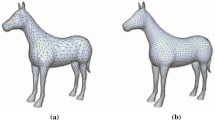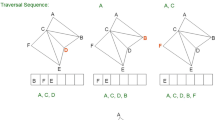Abstract
Most 3D steganographic algorithms emphasize high data capacity, low distortion, and correct data extraction. However, their disadvantage is in the existence of the same embedding capacity for each data-embedded vertex in the 3D models. Embedding the same capacity in the vertex located on the surface with different properties may cause obvious distortion, making it difficult to achieve the initial goal of information-hiding techniques. This study proposes a new and adaptive 3D steganographic algorithm that considers the surface complexity. To increase the accuracy of the complexity estimation for each embedding vertex, the proposed algorithm adopts a vertex decimation process to determine its referencing neighbors. Thereafter, different amounts of the secret messages are embedded according to the surface properties of each vertex. This approach preserves important shape features and produces a more imperceptible result. Experimental results show that the proposed adaptive algorithm can achieve more accurate estimation results with a higher data capacity and acceptable distortion. The proposed technique is feasible in 3D steganography.








Similar content being viewed by others
References
Benedens O (1999) Geometry-based watermarking of 3D models. IEEE Comput Graph Appl 19:46–55
Bogomjakov A, Gotsman C, Isenburg M (2008) Distortion-free steganography for polygonal meshes. Comput Graph Forum 27:637–642
Bors AG (2006) Watermarking mesh-based representations of 3-D objects using local moments. IEEE Trans Image Process 15:687–701
Cayre F, Macq B (2003) Data hiding on 3-D triangle meshes. IEEE Trans Signal Process 51:939–949
Chao MW, Lin CH, Yu CW, Lee TY (2009) A high capacity 3D steganography algorithm. IEEE Trans Vis Comput Graph 15:274–284
Cheng YM, Wang CM (2006) A high-capacity steganographic approach for 3D polygonal meshes. Vis Comput 22:845–855
Cheng YM, Wang CM (2007) An adaptive steganographic algorithm for 3d polygonal meshes. Vis Comput 23:721–732
Cignoni P, Rocchini C, Scopigno R (1998) Metro: measuring error on simplified surfaces. Comput Graph Forum 17:167–174
Cox IJ, Miller ML, Bloom JA, Fridrich J, Kalker T (2008) Digital watermarking and steganography, 2nd edn. Morgan Kaufmann, Burlington
Huang NC, Li MT, Wang CM (2009) Toward optimal embedding capacity for permutation steganography. IEEE Signal Process Lett 16:802–805
Kim K, Barni M, Tan HZ (2010) Roughness-adaptive 3d watermarking based on masking effect of surface roughness. IEEE Trans Inf Forensics Secur 5:721–733
Konstantinides JM, Mademlis A, Daras P, Mitkas PA, Strintzis MG (2009) Blind robust 3-D mesh watermarking based on oblate spheroidal harmonics. IEEE Trans Multimedia 11:23–38
Li MT, Huang NC, Wang CM (2011) A novel high capacity 3D steganographic algorithm. Int J Innovative Comput Inform Control 7:1055–1074
Lin HY, Liao HY, Lu CS, Lin JC (2005) Fragile watermarking for authenticating 3-D polygonal meshes. IEEE Trans Multimedia 7:997–1006
Ohbuchi R, Mukaiyama A, Takahashi S (2002) A frequency-domain approach to watermarking 3D shapes. Comput Graph Forum 21:373–382
Petitcolas P, Anderson RJ, Kuhn MG (1999) Information hiding—a survey. In: Proceedings of the IEEE, special issue on protection of multimedia content, vol 87, pp 1062–1078
Rencher AC (2002) Methods of multivariate analysis, 2nd edn. Wiley, New York
Schroeder WJ, Zarge JA, Lorensen WE (1992) Decimation of triangle meshes. ACM SIGGRAPH Comp Graph 26:65–70
Wang CM, Cheng YM (2005) An efficient information hiding algorithm for polygon models. Comput Graph Forum 24:591–600
Wang K, Lavoué G, Denis F, Baskurt A (2008) A comprehensive survey on three-dimensional mesh watermarking. IEEE Trans Multimedia 10:1513–1527
Wang K, Lavoué G, Denis F, Baskurt A (2008) Hierarchical watermarking of semiregular meshes based on wavelet transform. IEEE Trans Inf Forensics Secur 3:620–634
Yang Y, Ivrissimtzis I (2010) Polygonal mesh watermarking using Laplacian coordinates. Comput Graph Forum 29:1585–1593
Zafeiriou S, Tefas A, Pitas I (2005) Blind robust watermarking schemes for copyright protection of 3D mesh objects. IEEE Trans Vis Comput Graph 11:596–607
Acknowledgements
The author would like to thank the anonymous reviewers for their constructive comments. This work was supported by the National Science Council of Taiwan (Grant No. NSC 98-2221-E-468-017) and the research project of Asia University (Grant No. 100-A-04).
Author information
Authors and Affiliations
Corresponding author
Rights and permissions
About this article
Cite this article
Tsai, YY. An adaptive steganographic algorithm for 3D polygonal models using vertex decimation. Multimed Tools Appl 69, 859–876 (2014). https://doi.org/10.1007/s11042-012-1135-8
Published:
Issue Date:
DOI: https://doi.org/10.1007/s11042-012-1135-8




